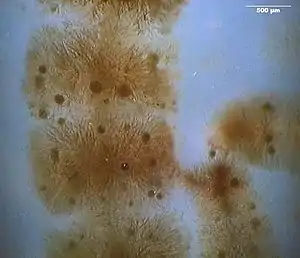Alge des Jahres
Die Alge des Jahres wird seit 2007 von der Sektion Phykologie in der Deutschen Botanischen Gesellschaft ernannt[1]. Gekürt werden Arten beziehungsweise Gattungen, die in ihrer ökologischen Bedeutung oder ihrer Bedrohung hervorhebenswert sind.
Algen des Jahres
| Jahr | deutscher Name | wissenschaftlicher Name | Abbildung |
|---|---|---|---|
| 2007 | – | Laminaria |  |
| 2008 | – | Micrasterias |  |
| 2009 | – | Emiliania huxleyi | .png.webp) |
| 2010 | Froschlaichalgen | Batrachospermum |  |
| 2011 | – | Fragilariopsis cylindrus | |
| 2012 | Armleuchteralgen | Chara |  |
| 2013 | – | Lingulodinium polyedrum |  |
| 2014 | – | Chlamydomonas reinhardtii |  |
| 2015 | Meersalat (Gattung) | Ulva |  |
| 2016 | Melosira arctica | ||
| 2017 | Blaugrüne Felskugel | Chroococcidiopsis (Gattung) |  |
| 2018 | – | Klebsormidium (Gattung) | .jpg.webp) |
| 2019 | Blutschneealge | Chlamydomonas nivalis
(revidiert: Sanguina nivaloides)[2] |
 |
| 2020 | – | Chromera velia | |
| 2021 | – | Vaucheria velutina |  |
| 2022 | – | Stylodinium |  |
Weblinks
- Alge des Jahres, Sektion Phykologie der Deutschen Botanischen Gesellschaft (DBG).
Einzelnachweise
- https://www.dbg-phykologie.de/alge-des-jahres
- Lenka Procházková, Thomas Leya, Heda Křížková, Linda Nedbalová: Sanguina nivaloides and Sanguina aurantia gen. et spp. nov. (Chlorophyta): the taxonomy, phylogeny, biogeography and ecology of two newly recognised algae causing red and orange snow. In: FEMS Microbiology Ecology. Band 95, Nr. 6, 1. Juni 2019, ISSN 1574-6941, S. fiz064, doi:10.1093/femsec/fiz064, PMID 31074825, PMC 6545352 (freier Volltext) – (oup.com [abgerufen am 9. März 2021]).
This article is issued from Wikipedia. The text is licensed under Creative Commons - Attribution - Sharealike. The authors of the article are listed here. Additional terms may apply for the media files, click on images to show image meta data.
